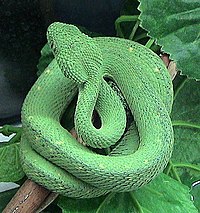Atheris chlorechis
| Atheris chlorechis | ||||||||||||||||||||
|---|---|---|---|---|---|---|---|---|---|---|---|---|---|---|---|---|---|---|---|---|
| Scientific classification | ||||||||||||||||||||
| ||||||||||||||||||||
| Binomial name | ||||||||||||||||||||
| Atheris chlorechis (Pel, 1851) | ||||||||||||||||||||
| Synonyms | ||||||||||||||||||||
|
Atheris chlorechis is a venomous viper species found only in the forests of West Africa.[2] No subspecies are currently recognized.[3]
Common names: western bush viper.[2]
Description
Adults average 50 cm in length with a maximum of 70 cm. The tail is relatively long. The body is relatively slender, with 25-36 mid-body rows of dorsal scales. These are heavily keeled, with the keels ending in a swelling at the end of each scale.[2] Adults have a uniform light green groundcolor, overlaid with a series of faint yellow, roughly paired spots running dorsally along the length of the body and about 2.5 cm apart. The belly is pale green in color.[2] Newborns are tan-brown in color, but this changes to a yellow-green hue with irregular dark spots within 24 hours.[4] This second color phase has been described as the reverse of that of the adults and is only seen in individuals less than 25 cm in length.[4][2]
Geographic range
Found in West Africa, including Guinea-Bissau, Guinea, Sierra Leone, Liberia, Ivory Coast, Ghana, Togo, Benin, isolated locations in Nigeria, Cameroon, Equatorial Guinea and Gabon. The type locality is listed as "Boutre, Ghana."[1]
Habitat
Found in forests, in dense foliage about 1-2 m above the ground.[2]
Feeding
Said to feed on rodents, lizards and tree frogs.[2]
Reproduction
Gives birth to 6-9 young in March to April. Newborns are 131-151 mm in length.[4]
Attribution
- Some content on this page may previously have appeared on Wikipedia.
Cited references
- ↑ Jump up to: 1.0 1.1 McDiarmid RW, Campbell JA, Touré T. 1999. Snake Species of the World: A Taxonomic and Geographic Reference, vol. 1. Herpetologists' League. 511 pp. ISBN 1-893777-00-6 (series). ISBN 1-893777-01-4 (volume).
- ↑ Jump up to: 2.0 2.1 2.2 2.3 2.4 2.5 2.6 Mallow D, Ludwig D, Nilson G. 2003. True Vipers: Natural History and Toxinology of Old World Vipers. Krieger Publishing Company, Malabar, Florida. ISBN 0-89464-877-2.
- ↑ Atheris chlorechis (TSN 634943) at Integrated Taxonomic Information System. Accessed 25 March 2007.
- ↑ Jump up to: 4.0 4.1 4.2 Spawls S, Branch B. 1995. The Dangerous Snakes of Africa. Ralph Curtis Books. Dubai: Oriental Press. 192 pp. ISBN 0-88359-029-8.
OTHER:
- Cansdale GS. 1961. West African Snakes. London: Longman's. 75 pp.
